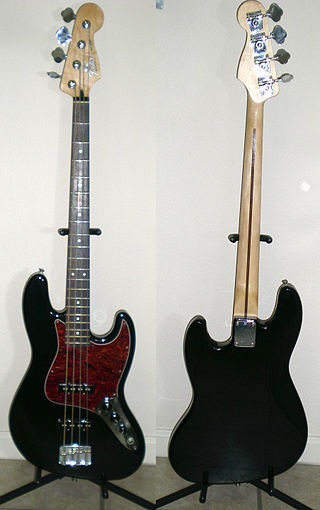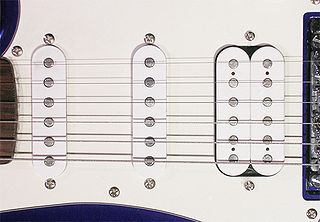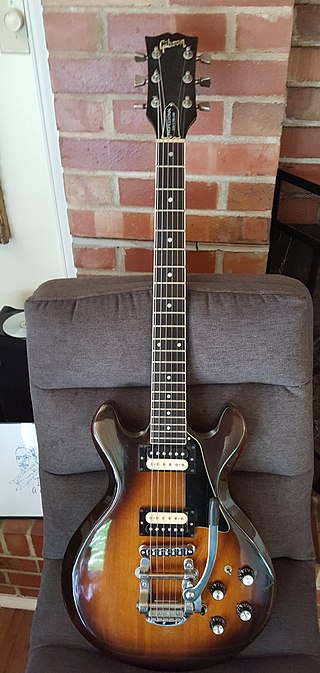
An electric guitar is a guitar that requires external amplification in order to be heard at typical performance volumes, unlike a standard acoustic guitar. It uses one or more pickups to convert the vibration of its strings into electrical signals, which ultimately are reproduced as sound by loudspeakers. The sound is sometimes shaped or electronically altered to achieve different timbres or tonal qualities from that of an acoustic guitar via amplifier settings or knobs on the guitar. Often, this is done through the use of effects such as reverb, distortion and "overdrive"; the latter is considered to be a key element of electric blues guitar music and jazz and rock guitar playing. Designs also exist combining attributes of the electric and acoustic guitars: the semi-acoustic and acoustic-electric guitars.
The Fender Jaguar is an electric guitar by Fender Musical Instruments characterized by an offset-waist body, a relatively unusual switching system with two separate circuits for lead and rhythm, and a short-scale 24" neck. Owing some roots to the Jazzmaster, it was introduced in 1962 as Fender's feature-laden top-of-the-line model, designed to lure players from Gibson. During its initial 13-year production run, the Jaguar did not sell as well as the less expensive Stratocaster and Telecaster, and achieved its most noticeable popularity in the surf music scene. After the Jaguar was taken out of production in 1975, vintage Jaguars became popular first with American punk rock players, and then more so during the alternative rock, shoegazing and indie rock movements of the 1980s and 1990s. Fender began making a version in Japan in the mid-1980s, and then introduced a USA-made reissue in 1999. Since then, Fender has made a variety of Jaguars in America, Mexico, Indonesia and China under both the Fender and Squier labels. Original vintage Jaguars sell for many times their original price.

The Fender Precision Bass is a model of electric bass guitar manufactured by Fender Musical Instruments Corporation. In its standard, post-1957 configuration, the Precision Bass is a solid body, four-stringed instrument usually equipped with a single split-coil humbucking pickup and a one-piece, 20-fret maple neck with rosewood or maple fingerboard.

The Fender Jazz Bass is the second model of electric bass created by Leo Fender. It is distinct from the Precision Bass in that its tone is brighter and richer in the midrange and treble with less emphasis on the fundamental frequency. The body shape is also different from the Precision Bass, in that the Precision Bass has a symmetrical lower bout on the body, designed after the Telecaster and Stratocaster lines of guitars, while the Jazz Bass has an offset lower bout, mimicking the design aesthetic of the Jaguar and Jazzmaster guitars.

A pickup is a transducer that captures or senses mechanical vibrations produced by musical instruments, particularly stringed instruments such as the electric guitar, and converts these to an electrical signal that is amplified using an instrument amplifier to produce musical sounds through a loudspeaker in a speaker enclosure. The signal from a pickup can also be recorded directly.

The G-400 is an Epiphone solid body electric guitar model produced as a more modestly priced version of the famous Gibson SG. Currently, Epiphone is a subsidiary of Gibson and manufactures the G-400 and other budget models at a lower cost in Asia. Visually and ergonomically, it is almost identical to a 1962 SG.

The Squier '51 is an electric guitar made by Squier, a subsidiary of Fender. The '51 is notable for being one of the few original designs made by Squier, which normally manufactures less expensive authorized copies of Fender's popular guitars and bass guitars.
The Fender Mustang Bass is an electric bass guitar model produced by Fender and Squier. Two variants, the Musicmaster Bass and the Bronco Bass, have also been produced from time to time using the same body and neck shape.

The Jackson Dinky is a Superstrat-style double-cutaway electric guitar built by Jackson Guitars. The "Dinky" is named for its slightly smaller than normal (7/8) body size. Usually fitted with a two humbucker pickup configuration, some models also include single-coil pickups and/or just one bridge humbucker. The fretboard can be made out of ebony, rosewood and more recently maple, or rock maple, with 24 jumbo frets and is always built with a bolt-on neck. Most of the guitars have a Floyd Rose original or licensed tremolo, and a locking nut to help maintain stable tuning. Some Dinkys have hardtail, or String-Thru bridges. The Jackson Dinky is usually preferred by players of hard rock and heavy metal.

The Fender Jaguar Bass is an electric bass guitar currently manufactured in Mexico by the Fender Musical Instruments Corporation.
A solid-body musical instrument is a string instrument such as a guitar, bass or violin built without its normal sound box and relying on an electromagnetic pickup system to directly detect the vibrations of the strings; these instruments are usually plugged into an instrument amplifier and loudspeaker to be heard. Solid-body instruments are preferred in situations where acoustic feedback may otherwise be a problem and are inherently both less expensive to build and more rugged than acoustic electric instruments.
The Fender Katana is an electric guitar built by Fender. It was designed by marketing director Dan Smith in 1985. The Katana was designed to compete with the unconventionally-shaped guitars of the era, such as the Jackson Randy Rhoads, and to satisfy Fender dealers who were suffering from the competition those instruments offered. The Katana did not sell as well as Fender hoped, and it was discontinued in 1986 before being reissued as a Masterbuilt Custom Shop model as part of the Prestige collection three decades later.

The Gibson L6-S is a solid body electric guitar. It was the descendant of the L5S jazz solid-body electric guitar. It was the same shape, very much like a wide Gibson Les Paul, but with a 24-fret neck, the first Gibson guitar to have this.
The Gibson Les Paul bass is a bass guitar first manufactured by Gibson in 1969, just after the relaunch of the Les Paul guitar in 1968.

The Gibson Nighthawk was a family of electric guitars manufactured by Gibson. Introduced in 1993, the Nighthawk represented a radical change from traditional Gibson designs. While its maple-capped mahogany body and set neck were reminiscent of the classic Gibson Les Paul, the Nighthawk incorporated a number of characteristics more commonly associated with Fender guitars. The Nighthawk was not a commercial success; production of all models was discontinued in 1998 after only five years.
Electric guitar design is a type of industrial design where the looks and efficiency of the shape as well as the acoustical aspects of the guitar are important factors. In the past many guitars have been designed with various odd shapes as well as very practical and convenient solutions to improve the usability of the object.
The Fender Elite Stratocaster is an electric solid body guitar that was manufactured by Fender in 1983 and 1984. The name was revived from 2016 to 2019 with the Fender American Elite Stratocaster Series.

The Gibson 335-S was a solid-body version of their very popular Electric Spanish guitar, the ES-335. Although a very similar shape, and with identical controls, being a solid-body rather than semi-acoustic guitar gave this model a rather different sound.
The Yamaha Corporation is a multinational corporation and conglomerate based in Japan with a wide range of products and services, predominantly musical instruments, motorcycles, power sports equipment and electronics.
The Fender Telecaster, colloquially known as the Tele, is an electric guitar produced by Fender. Together with its sister model the Esquire, it was the world's first mass-produced, commercially successful solid-body electric guitar. Its simple yet effective design and revolutionary sound broke ground and set trends in electric guitar manufacturing and popular music.












